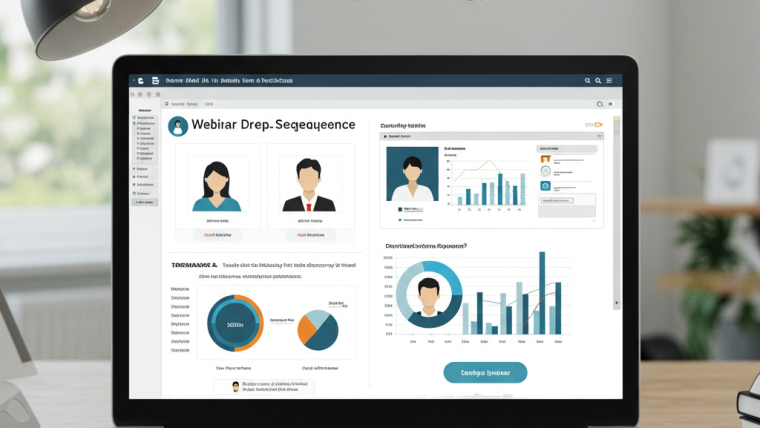In today’s world, webinars are everywhere — from corporate training sessions and online courses to product launches and digital summits. But have you ever paused to wonder, when did webinars start? Understanding the origin of webinars isn’t just about trivia — it’s about tracing the roots of a format that has changed the way we share knowledge, sell products, and connect with audiences.
The Birth of Webinars: A 1990s Innovation
The idea of hosting webinars dates back to the early nineties when the internet was in its adolescent stage. Even the very word “webinar” is a portmanteau of “web” and “seminar,” indicating its function right in its name – to aggregate individuals online for presentations, discussions or a combination of both.
One of the earliest examples of what we now call a webinar came from the software companies that were playing around with ways to demo products remotely. But as computers and dial-up connections became more widely available, businesses saw a new opportunity: They could substitute in-person seminars with online, real-time presentations that could reach more people, with none of the financial or logistical burden of travel.
One of the early companies working in the space was PlaceWare, a web conferencing company that was cofounded in 1996. Microsoft acquired it in 2003 and it eventually was folded into Microsoft Live Meeting — one of the first big platforms to be built for webinars.
The First Real-World Uses of Webinars
Business use was the first real use of webinars. In the late 1990s, businesses started using them to deliver training, sales pitches, and internal updates. Video quality was poor because of bandwidth, but they had the fundamentals there: audio narration, slide presentations, and live chat.
Webinars represented something radical for that time — live, online interactions in which people could participate in real time, ask questions, and even vote in polls. This level of engagement was an improvement over pre-recorded training tapes or static emails.
2000s: The Expansion of the Webinar Market
As broadband internet became more widespread in the early 2000s, the quality and functionality of webinars began to improve. Audio and video streaming became smoother, screensharing was introduced, and more companies entered the market.
Platforms like WebEx (founded in 1995) and GoToWebinar (launched in 2006) brought polished tools that were accessible even to non-tech-savvy users. Educational institutions, non-profits, and healthcare providers began to see the potential of webinars for training, outreach, and collaboration.
By this time, webinars were no longer just for sales demos — they had become a standard communication tool across industries.
The Role of Webinars During Global Events
The real test for webinars came during global events that restricted in-person interactions. For instance, during the 2008 financial crisis, companies cut travel budgets and leaned heavily on digital communication, pushing webinars into the spotlight.
But it was during the COVID-19 pandemic in 2020 that webinars truly exploded. Overnight, organizations of all sizes had to transition to remote work, remote education, and remote events. Platforms like Zoom, Microsoft Teams, and Google Meet saw unprecedented growth — not just for meetings, but for large-scale webinars reaching thousands of attendees.
During this time, people began attending webinars for fitness classes, cooking workshops, virtual conferences, and even weddings. The format proved flexible, scalable, and surprisingly human when done well.
Why Webinars Still Matter
Despite the world slowly returning to in-person gatherings, webinars remain a core component of digital communication. Why?
Because they offer
-
Scalability: You can host 5 or 5,000 attendees.
-
Accessibility: Anyone with an internet connection can join.
-
Engagement: Features like Q&A, polls, and chat keep people involved.
-
Cost-effectiveness: No need for venues, travel, or catering.
Today, brands use webinars for content marketing, lead generation, employee onboarding, and customer support. It’s no longer just a fallback — it’s a primary channel.
The Future of Webinars
Webinars have come a long way from their humble beginnings. Artificial intelligence, real-time analytics, automated follow-ups, and integration with CRM systems are now standard features.
We’re also seeing hybrid events, where webinars are part of a larger event that blends physical and digital elements. Virtual reality and 3D environments are slowly entering the space, offering immersive experiences that could redefine how we think about online presentations.
If you’re considering adding webinars to your strategy, you’re tapping into a proven medium. Companies like ClickMeeting are innovating fast, giving hosts advanced tools to connect with global audiences more effectively than ever.
Final Thoughts
So, when did webinars start? While the format technically began in the 1990s, it has grown rapidly in both scope and sophistication over the last three decades. What started as a simple way to present remotely is now a powerful tool for business, education, and community engagement.
And if you’re looking to make webinars a core part of your digital outreach or business strategy, it’s not too late to begin. Whether you’re a coach, educator, business owner, or marketer — the world is ready to listen, as long as you have something valuable to say.
For more insights on digital tools, webinars, and marketing strategies, check out our homepage at LiveCastHub — your resource for mastering modern communication.








Webinar Analytics: A Complete Guide to Measuring Success and Improving Performance
The Ultimate Webinar Follow-Up Strategy to Turn Attendees into Customers
Webinar Accessibility Best Practices: How to Make Your Online Events Inclusive for All
Webinar Personalization: Tailoring Content to Audience Segments for Maximum Engagement